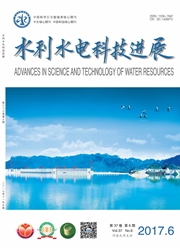

 中文摘要:
中文摘要:
采用有限单元法对龙开口碾压混凝土坝9 号泄流中孔坝段施工期和运行期的温度场、应力场进行了全过程仿真分析,应力计算考虑了坝体自重、静水压力、温度荷载、随龄期而变化的混凝土弹性模量、混凝土徐变等因素.仿真结果表明:坝体泄流孔口在施工期形成了3-4 MPa 的高拉应力,但运行期后应力减小至2 MPa;坝体上部由于在夏季浇筑温度较高,温降后形成的大温差产生了较高拉应力,但10 a 后应力状态改善;大坝除坝踵处出现应力集中外,整体压应力水平小于2 MPa;孔口附近及大坝整体的应力状态是基本安全的.
 英文摘要:
英文摘要:
The finite element method was used to simulate the temperature and stress fields of the ninth discharge section of the Longkaikou Roller-Compacted Concrete ( RCC) gravity dam throughout the process of the construction and operation periods. The gravity load, hydrostatic pressure, temperature load, change of Young’ s modulus with age, and creep effect of concrete were considered in the calculation of the stress field. The results show that high tensile stresses of 3 to 4 MPa occur near the discharge orifice in the construction period, but decreas to 2 MPa in the operation period. High tensile stress also occurs in the upper portion of the dam due to the high pouring temperature in summer and a large temperature drop after construction, but the stress state will be improved after 10 years of operation. The compression stress of the dam is less than 2 MPa, except for higher compression stress at the dam heel due to stress concentration. The stress states near the discharge orifice and in the dam body indicate that the dam is basically safe.
 同期刊论文项目
同期刊论文项目
 同项目期刊论文
同项目期刊论文
 期刊信息
期刊信息
